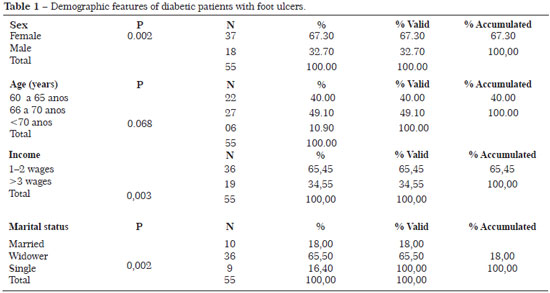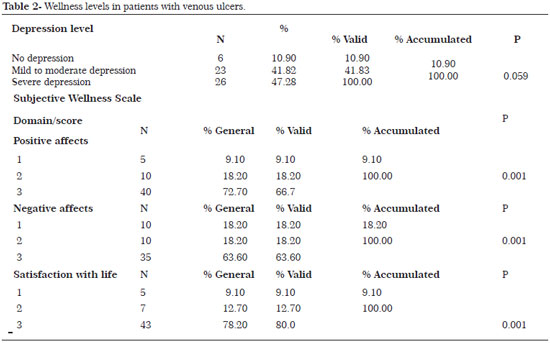ABSTRACT
INTRODUCTION: Venous ulcers play an important role in patients' lives, as the deformities caused by this type of wound can lead to various adverse effects, including psychosocial disorders.
OBJECTIVE: To evaluate subjective wellness and depression in elderly patients with venous ulcers.
METHODS: This is a primary, descriptive, analytical, and multicenter clinical study involving 55 elderly patients with venous ulcers, undergoing treatment at the Nursing Assistance and Training Center of Clínicas Samuel Libânio Hospital, at the São João Outpatient Clinic of the University of Vale do Sapucaí and at the Primary Healthcare Units of Pouso Alegre city. The study included male and female patients, aged 360 years, and with an ankle-brachial index between 0.8 and 1.0. Data were collected between December 2012 and May 2013, after approval by the research ethics committee of the Faculty of Health Sciences Dr. José Antônio Garcia Coutinho, under recommendation 3.090.46. Sociodemographic data, Yesevage's reduced version of the Geriatric Depression Scale, and the Subjective Wellness Scale were used. Statistical analyses were carried out with the chi-square and Student's t tests.
RESULTS: Most of the study participants were female; 22 (40%) of the patients were aged 60-65 years and 27 (49.10%) were aged 66-70 years. Their income ranged between 1 and 2 minimum wages, and most of them are widowers. Twenty-three (41.82%) elderly patients with venous ulcers had mild to moderate depression levels, and 26 (47.28%) showed severe depression. In the Subjective Wellness Scale, most study participants revealed changes in items 43 (satisfaction with life; 78.20%) and 40 (72.70%).
CONCLUSION: This study revealed that study participants had mild to severe depression and decreased quality of life.
Keywords:
Venous ulcer; Leg ulcer; Depression; Quality of life; Elderly.
RESUMO
INTRODUÇÃO: A úlcera venosa assume grande importância na vida dos pacientes, pois a ocorrência de deformidade causada por este tipo de ferida pode gerar consequência advensas as causais inclui distúrbios psicossocial. Avaliar bem-estar subjetivo e depressão em pessoas idosas com úlcera venosa.
MÉTODOS: Estudo clínico, primário, descritivo, analítico e multicêntrico. Participaram 55 indivíduos idosos com úlcera venosa, atendidos no Núcleo de Assistência e Ensino em Enfermagem do Hospital das Clínicas Samuel Libânio, no Ambulatório São João da Universidade do Vale do Sapucaí e nas Unidades Básicas de Saúde da cidade de Pouso Alegre. Foram incluídos pacientes com idade acima de 60 anos, ambos os sexos, índice tornozelo/braço entre 0,8 e 1,0. Os dados foram coletados no período compreendido entre dezembro de 2012 a maio de 2013, após aprovação Comitê de Ética em Pesquisa da Faculdade de Ciências da Saúde Dr. José Antônio Garcia Coutinho sob parecer 3.090.46. Os instrumentos utilizados foram: dado sócio demográfico, Escala de Depressão Geriátrica em versão reduzida de Yesavage e Escala de Bem-estar Subjetivo. Para análise estatística foi realizado os testes: Qui-Quadrado, t de Student.
RESULTADOS: A Maioria, dos indivíduos, era do sexo feminino, 22(40%) tinham entre 60 e 65 anos, 27(49,10%) entre 66 e 70 anos, tinham de 1 a 2 salários mínimos e viúvo. Foram identificados 23 (41,82%) idosos com úlcera venosa nível da depressão leve ou moderada, e 26(47,28%) depressão severa. Relacionado à Escala Bem-estar Subjetivo a maioria dos participantes do estudo apresentaram alteração nos domínios: 43(78,20%), satisfação com a vida, e 40 (72,70%).
CONCLUSÃO: Através deste estudo concluímos que os indivíduos que participaram da pesquisa apresentam depressão entre leve a severa e queda na qualidade de vida. Sentem-se infelizes, e insatisfeitos com a vida.
Palavras-chave:
Úlcera venosa; Úlcera de perna; Depressão; Qualidade de vida; Idoso.









